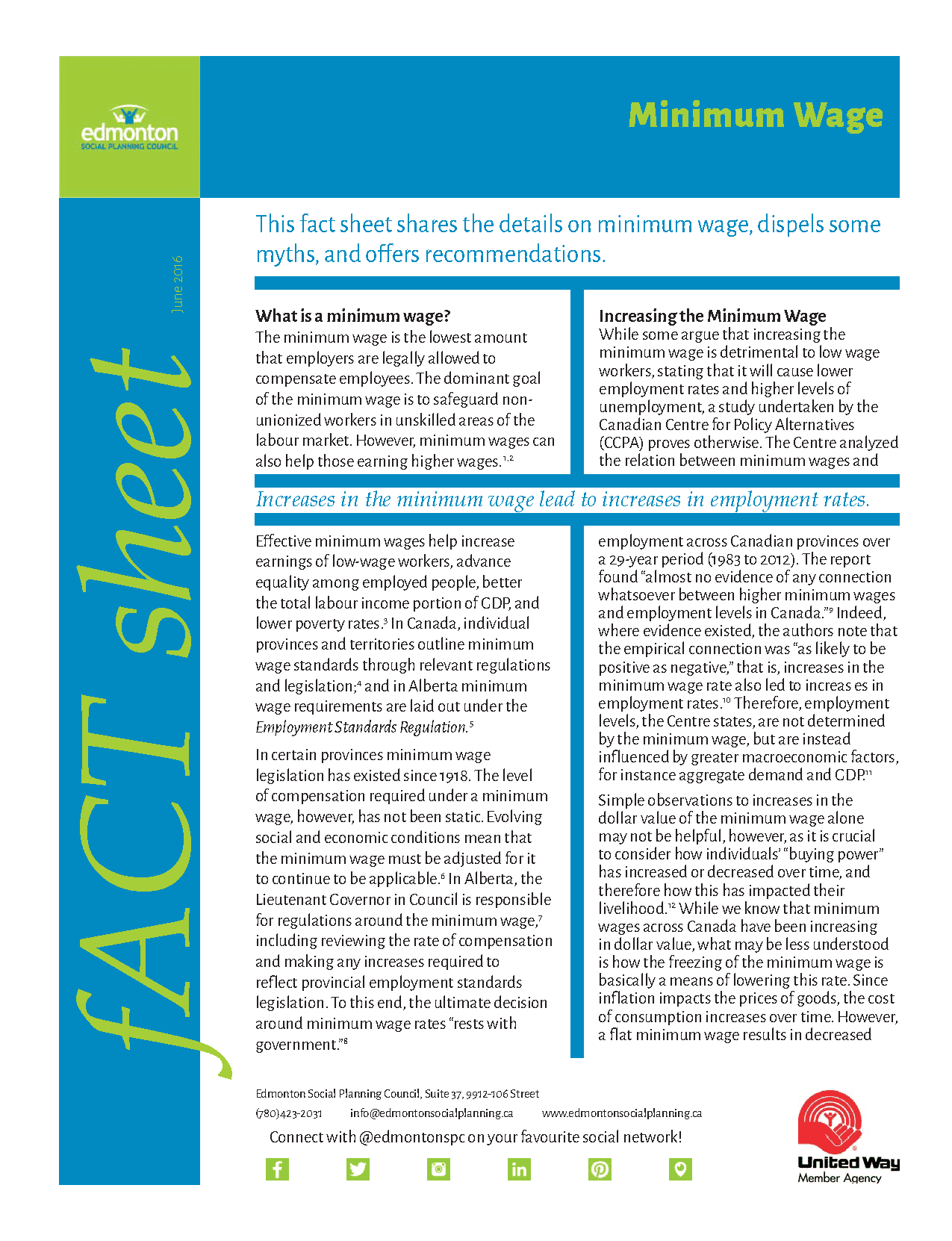Title:Why do some employers prefer to interview Matthew, But Not Samir?: new evidence from Toronto, Montreal and Vancouver.
Author(s):Oreopoulos, Philip|split|Dechief, Diane
Corporate Author: Metropolis British Columbia
Subject:Discrimination|split|Racism
Publisher:Metropolis British Columbia
Place of Publication:Burnaby BC
Vancouver
Date of Publication:2011
Language:English
Series:Working Paper Series
Material Type:Report
Category: Labour: Employment
-
2011 WP11-13
-
Edmonton’s 2016 living wage: $16.69 per hour
 Edmonton’s 2016 living wage: $16.69 per hour
Edmonton’s 2016 living wage: $16.69 per hourEdmonton Social Planning Council releases annual report
By: Alex Boyd Metro Published on Thu Jun 23 2016
Two working adults living in the city with two kids would each have to make $16.69 an hour in order to make ends meet, according to the Edmonton Living Wage Report released Thursday.
The Edmonton Social Planning Council calculates the living wage every year, using cost of living estimates for Edmonton. They also take into account dollars coming in from government transfers and additional costs like EI and CPP premiums.The living wage for 2016 is actually 67 cents less than last year, because of child benefit increases from both the federal and provincial governments.
“Our hope is that more Edmonton employers will rise to the challenge and commit to paying a living wage to all their employees,” said ESPC Research Coordinator John Kolkman in a release.
“Research indicates that employers paying a living wage benefit from decreased staff turnover, improved productivity and reduced absenteeism.”Read the whole article on the Metro.
Download our Living wage report.
-
Edmonton’s 2016 living wage calculated to be $16.69 per hour
June 23, 2016
For Immediate ReleaseEdmonton’s 2016 living wage calculated to be $16.69 per hour
The Edmonton Social Planning Council estimates that two working adults, caring for two children, would need to each earn $16.69 per hour in 2016 to meet their basic needs.
The living wage is calculated using detailed financial accounting based on actual Edmonton living costs with government transfers added in, and EI and CPP premiums and federal and provincial income taxes deducted.
Edmonton’s living wage dropped by $0.67 per hour in the past year. The decrease is almost entirely due to increases in benefits from the federal and provincial governments.
“Starting in July 2016, this Edmonton family of four will receive an additional $239 per month from the new Canada Child Benefit compared to the previous child benefits plan. This family will also receive an additional $44 per month starting in July from enhancements made to the Alberta Family Employment Tax Credit,” said ESPC Research Coordinator John Kolkman.
While a minimum wage reflects the hourly wage employers must legally pay their employees, a living wage represents the hourly wage needed to maintain a modest standard of living in a specific community.
“With the significant increases in child benefits contributing to a reduced level of living wage, our hope is that more Edmonton employers will rise to the challenge and commit to paying a living wage to all their employees. Research indicates that employers paying a living wage benefit from decreased staff turnover, improved productivity and reduced absenteeism,” noted Kolkman.
The City of Edmonton’s End Poverty in Edmonton report specifically lists advocating for living wages for Edmontonians as a priority. “In the coming year, we plan to work with the City and community partners to recognize employers who provide living wages, and challenge others to do so as well,” Kolkman concluded.
For more information:
John Kolkman, ESPC Research Coordinator
(587)989-4442
jkolkman@edmontonsocialplanning.caMore than Minimum: Edmonton's Living Wage Report: 2016 Update, and a fACT Sheet on the minimum wage, are available at https://edmontonsocialplanning.ca/.
Information about living wage calculations in other Canadian cities available at: http://www.livingwagecanada.ca/
-
fACT Sheet—Minimum Wage
 What is minimum wage? Who works at minimum wage? What effect does a raise in minimum wage have on employers? Employees? What's up with the magic number of $15/h? And, what's the difference between a living wage and a minimum wage? All this and more in our latest fACT Sheet!
What is minimum wage? Who works at minimum wage? What effect does a raise in minimum wage have on employers? Employees? What's up with the magic number of $15/h? And, what's the difference between a living wage and a minimum wage? All this and more in our latest fACT Sheet!Download the Minimum Wage fACT Sheet today!
-
2009 Green Jobs Report
Â
Title:Green jobs: it’s time to build Alberta’s future.
Author(s):Thompson, David
Corporate Author: Sierra Club Prairie
Greenpeace
The Alberta Federation of Labour
Subject:Employment – general|split|Environmental issues – general
Publisher:Greenpeace
Sierra Club Prairie
Alberta Federation of Labour
Place of Publication:Toronto
Date of Publication:2009
Abstract:Labour and environmental groups are coming together – around the world and right here in Alberta – to call on governments to create green jobs. For too long, the two groups have been pitted against one another. The story crafted by political and business elites is that you can either have jobs or you can have a clean environment, but you can’t have both. However, people don’t buy that story anymore. The days of the jobs vs. environment myth are numbered. Environmental problems are increasingly seen as challenges to be overcome, and as opportunities to create good jobs cleaning up the environment. The emerging cooperation between labour and environmental groups is flipping the traditional story, and creating a new way to see the environment and the economy. People get it. They understand that you can have a clean environment and a strong economy, and they like the idea of governments pursuing policies that will lead to the creation of green jobs. The Alberta government can start right now, putting tens of thousands of Albertans back to work, building a cleaner, greener economy. The policy measures needed are straightforward, and the investments are very affordable. Certainly, they will create far more jobs than we are getting by throwing money at the oil and gas sector. With the potential for tens of thousands of green jobs, and a cleaner and greener economy, the real question is: can Alberta afford to not make the investment?
Table Of Contents:
Executive Summary Introduction What are green jobs? Why green jobs? The economic downturn requires fiscal stimulus We need to tackle global warming and other environmental issues Alberta’s employment picture The future of fossil fuels and employment Other rural jobs in decline Being a leader in the green economy . Green jobs sectors How many green jobs should Alberta aim to create? Replacing lost jobs Funds available for a green jobs stimulus Funding sources Sources of loan capital Conclusion: financing green jobs won’t be a problem Policies for creating green jobs Build Alberta’s energy efficiency Representative jobs Expand transit and create high-speed rail Representative jobs Accelerate renewable energy development Representative jobs Create other green jobs Meet the skills demand – education, training and transition Create a provincial green jobs strategy Timing and shape of the green jobs transition Short term: invest in creating green jobs over the next two years Medium term: diversify and consolidate green jobs gains Conclusion Appendix 1 – Home energy efficiency: employment and investment Appendix 2 – Eliminating fossil fuel handouts creates green jobs Appendix 3 – Reducing greenhouse gas emissions Endnotes
Language:English
Material Type:Report -
2006 Working Expected Work
Title:Working, expected to work project
Corporate Author: R.A. Malatest & Associates Ltd.
Subject:Employment – training|split|Employment – programs, services
Publisher:Alberta Human Resources and Employment
Place of Publication:Edmonton
Date of Publication:2006
Abstract:The Working, Expected to Work Project was undertaken to review the existing benefits and services received by working ETW clients to determine the challenges they face in becoming self-sufficient.
Language:English
Â
Material Type:Report